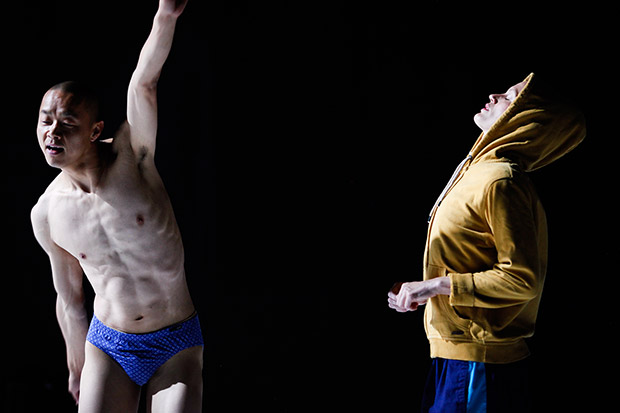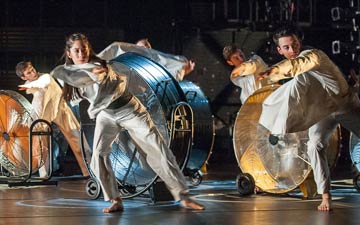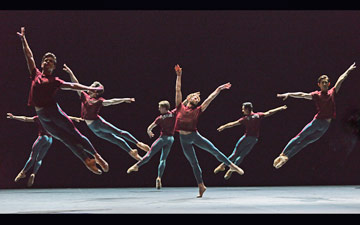
© Julia Gat. (Click image for larger version)
Emanuel Gat Dance
WORKS
★★✰✰✰
London, Sadler’s Wells
11 November 2019
emanuelgatdance.com
www.sadlerswells.com
There are six distinct works that, taped together, form WORKS, a creation originally made for Ballet de Lyon by Emanuel Gat and now recreated on his own nascent company. It adds up to a beguiling, albeit uneven and often inaccessible, 70-something minutes of dance. I may not have grasped all the challenges that Gat sets for his audience (in fact very few of them) but he kept my “what happens next” antenna always on the alert.
The best elements came in the flowing multiplicity of movements amongst the whole group of ten dancers in the opening and closing sections and in fascinating interactions between them. There is no narrative but a subliminal societal structure seemed to infuse each sequence and it was interesting to note how smaller, familial clusters of performers seemed to persist within the whole. Even though each performer had their own distinct costume – a bearded man in a tartan kilt with yellow socks and another in a dress, for example – it was difficult afterwards to effect individual identifications, but this seems to be an ensemble without individual stars. All ten have a long track record with Gat and he credits each of them for being part of the creative process.
The work opened with a digital clock showing 9:50 in red fluorescent dots and after a preamble, the numbers counted down as minutes and seconds. It was reminiscent of Merce Cunningham’s Ocean, which – performed in a circular space – reversed from 90 minutes until the end. Here, however, the clock was removed after the first group work and I felt the loss of its premature disappearance. Incidentally, the programme contains a series of notes from the choreographer each introduced with a hashtag. One text – possibly aimed at Cunningham – criticises ‘individuals who think their own specific way of moving should be turned into a generic technique’.

© Julia Gat. (Click image for larger version)
Another of Gat’s pronouncements is that ‘choreography can only be seen through intense attention’ and these WORKS live up to his principle. There are myriad simultaneous and consecutive sequences of action that require pinpoint timing and intense concentration, a serious discipline that is masked by the dancers’ casual demeanour. These are excellent dancers, without doubt, and their complex interactions are secured on the strength of that collective experience.
The choreography is often busy with different dancers creating a mix of shapes and sculptural poses, both individually, as couples and in trios, with much stretching and reaching out to maximum extension. And, then there is stillness, used here to create strong contrasts. When performers are not in motion they are often casually leaning against the back wall, as dark shadows behind the light. Throughout the work there are audible vocal commands from within the group. There must be considerable scope here for improvisation but it is cleverly absorbed within a formal structure in which you just can’t see the joins.
The work opens in silence but each of the six sections is made to different musical inspirations, from a recording of Jessye Norman singing a Richard Strauss song (Im Abendrot) through to another live recording, of Nina Simone performing Sinnerman. These opening and closing pieces were for the whole group and they worked well. Gat himself created music for the second section, throbbing electronica infused with sounds of dripping water, which formed the aural backdrop to a long and absorbing duet. In a later section there was a sensational piece of structured, partnered choreography for three dancers, moving in clever, close unison involving strong balance and support.
These highlights were pinnacles that rose out of other material which was less memorable, albeit expertly crafted, and there was that social contract between choreographer and audience requiring intense attention to absorb the cleverness of it all. I had never less than full admiration for the performers, but it felt as if I was watching them perform an unfamiliar play in a language in which I recognised or understood just a few isolated phrases. What I would really like to do is deconstruct the whole experience, break it down into bite-sized chunks to be analysed at my leisure. But, for me, as for almost every other audience member, such an indulgence is never going to happen.

















You must be logged in to post a comment.